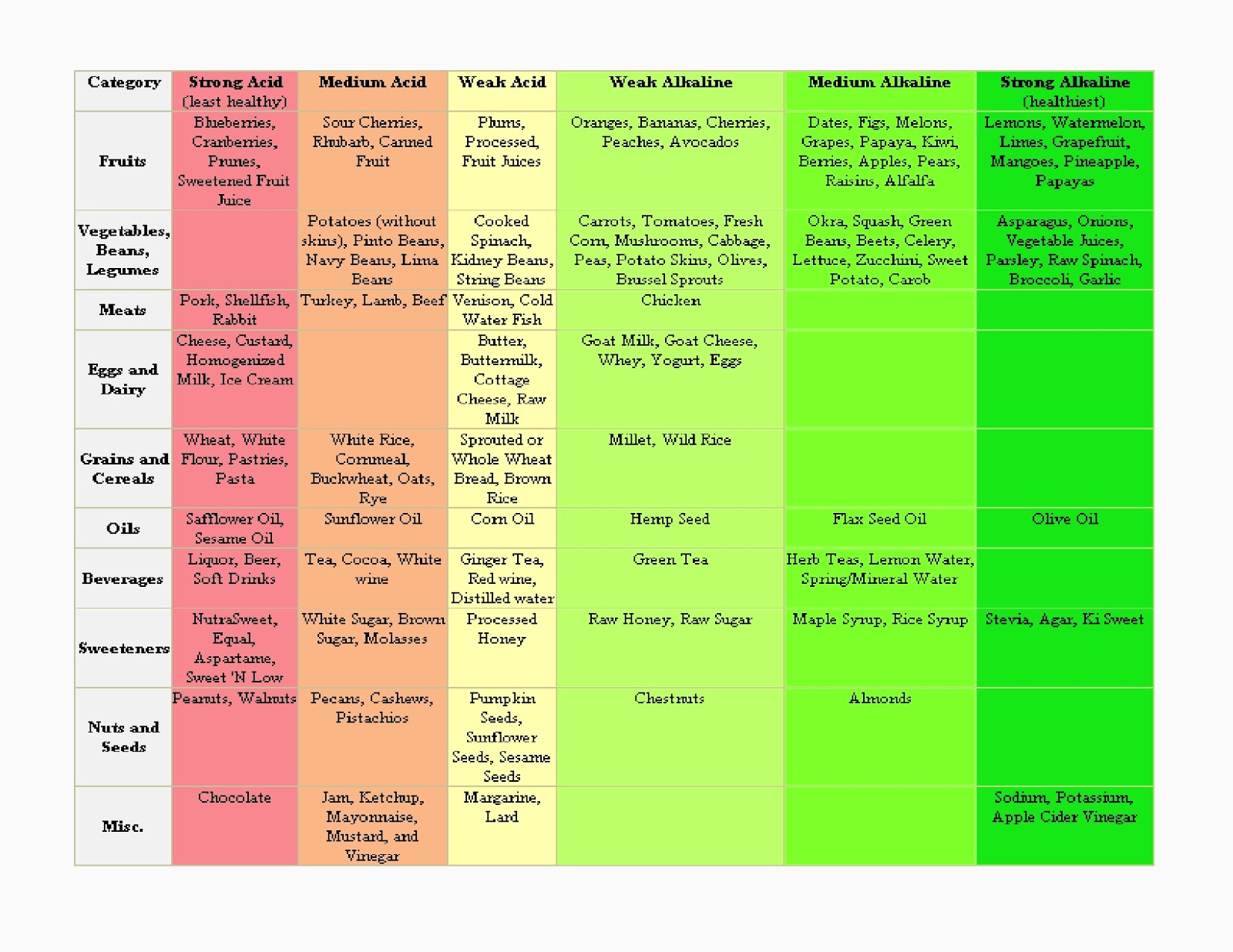Alkalizing the body is probably the
best thing that a person can do to ensure good health and well being. There is
a direct relationship between a person's pH and the oxygen content of his
blood, and a tiny change in pH can have dramatic effects upon a person's oxygen
intake. An alkaline body pH will prevent diseases, and will cure existing
ones by exponentially boosting a body's oxygen intake. As a general rule,
pathogens and cancers cannot survive in an oxygen-rich, alkaline environment.
Alkalizing the body is not an easy
task for most people, but the benefits are many. This chart shows the effects
of various foods on the human body. As you may notice, the initial pH of the
food is irrelevant. For instance, while lemons and limes are naturally acidic
fruits, they have a strong alkalizing effect upon the body when processed in
digestion. For more information on the benefits of alkalinity, read The Link Between
Body pH and Disease. You should also watch our documentary, The Cancer
Report.
Pharmaceuticals are usually
inherently toxic to the human body, and they cause disruptions in the
gastrointestinal tract. They often cause the stomach to poorly digest foods,
which results in malnourishment. The lack of absorbed minerals offsets the pH
of the body, which causes a cascading snowball effect in which it is less able
to absorb other nutrients. In this state, the body is more vulnerable to
sickness and cancers. The medical establishment describes the most toxic drugs
as being strong. So, the stronger drugs are those which will imbalance the pH
the most, and will cause cascading health problems.
We cannot fairly give credit to any
person or group for the chart below, because it was compiled from, and verified
with, dozens of sources. We welcome any verifiable information that could be
used to expand this chart. Unfortunately, it appears that most foods have not
yet been through the mineral testing required to definitively ascertain their
pH-shifting properties.
|
Category
|
Strong
Acid(least healthy)
|
Medium
Acid
|
Weak
Acid
|
Weak
Alkaline
|
Medium
Alkaline
|
Strong
Alkaline(healthiest)
|
|
Fruits
|
Blueberries,
Cranberries, Prunes, Sweetened Fruit Juice
|
Sour
Cherries, Rhubarb, Canned Fruit
|
Plums,
Processed, Fruit Juices
|
Oranges,
Bananas, Cherries, Peaches, Avocados
|
Dates,
Figs, Melons, Grapes, Papaya, Kiwi, Berries, Apples, Pears, Raisins, Alfalfa
|
Lemons,
Watermelon, Limes, Grapefruit, Mangoes, Pineapple, Papayas
|
|
Vegetables,
Beans, Legumes
|
Potatoes
(without skins), Pinto Beans, Navy Beans, Lima Beans
|
Cooked
Spinach, Kidney Beans, String Beans
|
Carrots,
Tomatoes, Fresh Corn, Mushrooms, Cabbage, Peas, Potato Skins, Olives, Brussel
Sprouts
|
Okra,
Squash, Green Beans, Beets, Celery, Lettuce, Zucchini, Sweet Potato, Carob
|
Asparagus,
Onions, Vegetable Juices, Parsley, Raw Spinach, Broccoli, Garlic
|
|
|
Meats
|
Pork,
Shellfish, Rabbit
|
Turkey,
Lamb, Beef
|
Venison,
Cold Water Fish
|
Chicken
|
||
|
Eggs
and Dairy
|
Cheese,
Custard, Homogenized Milk, Ice Cream
|
Butter,
Buttermilk, Cottage Cheese, Raw Milk
|
Goat
Milk, Goat Cheese, Whey, Yogurt, Eggs
|
|||
|
Grains
and Cereals
|
Wheat,
White Flour, Pastries, Pasta
|
White
Rice, Cornmeal, Buckwheat, Oats, Rye
|
Sprouted
or Whole Wheat Bread, Brown Rice
|
Millet,
Wild Rice
|
||
|
Oils
|
Safflower
Oil, Sesame Oil
|
Sunflower
Oil
|
Corn
Oil
|
Hemp
Seed
|
Flax
Seed Oil
|
Olive
Oil
|
|
Beverages
|
Liquor,
Beer, Soft Drinks
|
Tea,
Cocoa, White wine
|
Ginger
Tea, Red wine, Distilled water
|
Green
Tea
|
Herb
Teas, Lemon Water, Spring/Mineral Water
|
|
|
Sweeteners
|
NutraSweet,
Equal, Aspartame, Sweet 'N Low
|
White
Sugar, Brown Sugar, Molasses
|
Processed
Honey
|
Raw
Honey, Raw Sugar
|
Maple
Syrup, Rice Syrup
|
Stevia,
Agar, Ki Sweet
|
|
Nuts
and Seeds
|
Peanuts,
Walnuts
|
Pecans,
Cashews, Pistachios
|
Pumpkin
Seeds, Sunflower Seeds, Sesame Seeds
|
Chestnuts
|
Almonds
|
|
|
Misc.
|
Chocolate
|
Jam,
Ketchup, Mayonnaise, Mustard, and Vinegar
|
Margarine,
Lard
|
Sodium,
Potassium, Apple Cider Vinegar
|
Article Source:
Written by C. Thomas Corriher, The Health Wyze Report
Written by C. Thomas Corriher, The Health Wyze Report










0 comments:
Post a Comment